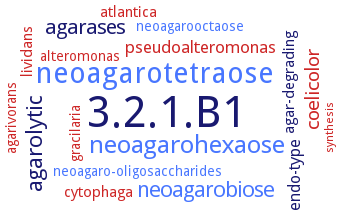3.2.1.B1: extracellular agarase
This is an abbreviated version!
For detailed information about extracellular agarase, go to the full flat file.

Word Map on EC 3.2.1.B1 
-
3.2.1.B1
-
neoagarotetraose
-
neoagarohexaose
-
agarolytic
-
neoagarobiose
-
agarases
-
coelicolor
-
pseudoalteromonas
-
endo-type
-
lividans
-
agar-degrading
-
atlantica
-
cytophaga
-
neoagaro-oligosaccharides
-
gracilaria
-
agarivorans
-
neoagarooctaose
-
alteromonas
-
synthesis
- 3.2.1.B1
- neoagarotetraose
- neoagarohexaose
-
agarolytic
- neoagarobiose
- agarases
- coelicolor
- pseudoalteromonas
-
endo-type
- lividans
-
agar-degrading
- atlantica
- cytophaga
- neoagaro-oligosaccharides
- gracilaria
- agarivorans
- neoagarooctaose
- alteromonas
- synthesis
Reaction
hydrolysis of 1,3-beta-D-galactosidic linkages in agarose, giving the octamer as the predominant product =
Synonyms
Aga21, AgaA, AgaA7, AgaB, AgaB1, AgaC, AgaG1, agaM1, agarase AG-b, agarase-a, agarase-b, beta-agarase, beta-agarase AgaB, endo-acting beta-agarase, endo-type beta-agarase, exo-beta-agarase, extracellular beta-agarase, NifU, YM01-3
ECTree
Advanced search results
Engineering
Engineering on EC 3.2.1.B1 - extracellular agarase
Please wait a moment until all data is loaded. This message will disappear when all data is loaded.
L122Q
-
mutant enzyme shows similar thermostability with wild-type AgaB. Specific activity 1.3fold higher than that of wild-type enzyme
N446I
-
mutant enzyme has enhanced thermostability. 10-20% decrease of the specific activity compared to wild-type enzyme
N446L
-
half-life of mutant enzyme at 40°C is 12.9fold longer than that of wild-type AgaB
N446V
-
half-life of mutant enzyme at 40°C is 18.2fold longer than that of wild-type AgaB
additional information
-
to increase the thermostability of beta-agarase AgaB by directed evolution, the mutant gene libraries are generated by error-prone polymerase chain reaction and deoxyribonucleic acid shuffling. A mutant S2 is obtained through two rounds of error-prone polymerase chain reaction and a single round of DNA shuffling and selection. It has higher thermostability and slightly increased catalytic activity than wild-type AgaB. Melting temperature (Tm) of S2, as determined by circular dichroism, is 4.6°C higher than that of wild-type AgaB, and the half-life of S2 is 350 min at 40°C, which is 18.4-fold longer than that of the wild-type enzyme. Saturation mutagenesis and hydrophobic cluster analysis indicate that hydrophobic interaction might be the key factor that enhances the enzyme stability


 results (
results ( results (
results ( top
top






